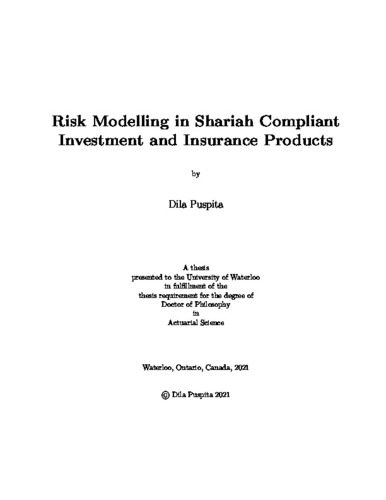| dc.contributor.author | Puspita, Dila | |
| dc.date.accessioned | 2021-09-28 19:54:24 (GMT) | |
| dc.date.available | 2021-09-28 19:54:24 (GMT) | |
| dc.date.issued | 2021-09-28 | |
| dc.date.submitted | 2021-09-23 | |
| dc.identifier.uri | http://hdl.handle.net/10012/17571 | |
| dc.description.abstract | The main objective of this study is to develop a risk model for Shariah (Islamic) compliant investment and insurance. Islamic finance is a part of Socially Responsible Investment (SRI) that incorporates religious ethics. In the first part, we propose a portfolio optimization model that complies with Shariah rules. Motivated by the Markowitz's mean variance model, this study proposes a new portfolio optimization model that takes into consideration both processes of purification and screening, which are key to constructing a Shariah-compliant portfolio. The model reflects the stochastic nature of purification and applies to both investment and dividend purification. Recognizing the importance of on-going screening and that assets that subsequently become non-compliance during the investment horizon could adversely affect the portfolio strategy, we impose probabilistic constraints to control the risk of compliance change. We conduct an extensive empirical study using a sample of Shariah-compliant public companies listed on the Indonesia Stock Exchange. We evaluate our proposed model by formulating the probabilistic constraints at both asset and portfolio levels, together with three different financial screening divisors that are broadly used by the international Shariah boards. The empirical results demonstrate that the effect of imposing non-compliance probabilistic constraints is highly sensitive to the adopted divisors and that these constraints can be an effective way of mitigating the risk of compliance change, thereby avoiding involuntary asset liquidation, and enhancing the performance of the resulting Shariah-compliant portfolio.
We extend the Shariah portfolio model to the multiperiod problem consisting of a risk-free asset and risky assets in the second part of this thesis. We assume geometric Brownian motion to capture the dynamic of purified asset return, and we apply two assumptions for the dynamic of the screening financial ratio. In the first one, we assume that the financial ratios are independent and follow beta distributions. The second assumption relaxes the independence assumption by allowing the financial ratios to follow the Beta-AR(p,q) model. We also take into account other Shariah constraints, namely no-short selling and no-leverage restrictions. We solve the multiperiod mean-variance Shariah portfolio problem using a pre-commitment approach and adopt the multi-stage strategy following by Stochastic Grid Bundling Method (SGBM) to find the optimal asset allocations. Finally, we apply the proposed algorithm to generate Shariah portfolio efficient frontiers for multiperiod time cases to see the impact of each Shariah variable on the performance of the portfolio. The empirical simulations show that the proposed probabilistic Shariah screening constraint is efficient in maintaining the sustainability of the asset in the portfolio.
In the third part of this study, we construct a new risk model representing the Hybrid-Takaful (Islamic Insurance) framework and develop a computational procedure to calculate the associated ruin probability. The Hybrid-Takaful business model applies a Wakalah (agent-based) contract for underwriting activities and Mudharabah (profit sharing) contracts for investment activities. We consider the existence of the qard-hasan facility provided by the operator (shareholder) as a benevolent loan for participants' fund in case of a deficit. This facility is a no-interest loan that will be repaid if the business generates profit in the future. For better investment management, we propose a separate investment account of participants' fund. We implement several numerical examples to analyze the impact of several parameters on the Takaful business model. We also find that our proposed Takaful model has a better performance compare with the conventional counterpart in terms of the probability of ruin. At the end of this thesis, we describe the conclusions and possible future research topic for each component of this thesis. | en |
| dc.language.iso | en | en |
| dc.publisher | University of Waterloo | en |
| dc.subject | Islamic finance | en |
| dc.subject | Portfolio optimization | en |
| dc.subject | Takaful | en |
| dc.subject | ruin probability | en |
| dc.subject | Socially Responsible Investment | en |
| dc.subject | Shariah compliant portfolio | en |
| dc.title | Risk Modelling in Shariah Compliant Investment and Insurance Products | en |
| dc.type | Doctoral Thesis | en |
| dc.pending | false | |
| uws-etd.degree.department | Statistics and Actuarial Science | en |
| uws-etd.degree.discipline | Actuarial Science | en |
| uws-etd.degree.grantor | University of Waterloo | en |
| uws-etd.degree | Doctor of Philosophy | en |
| uws-etd.embargo.terms | 0 | en |
| uws.contributor.advisor | Kolkiewicz, Adam | |
| uws.contributor.advisor | Tan, Ken Seng | |
| uws.contributor.affiliation1 | Faculty of Mathematics | en |
| uws.published.city | Waterloo | en |
| uws.published.country | Canada | en |
| uws.published.province | Ontario | en |
| uws.typeOfResource | Text | en |
| uws.peerReviewStatus | Unreviewed | en |
| uws.scholarLevel | Graduate | en |

